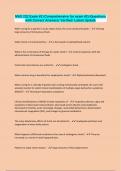NSG 232 Exam #2 (Comprehensive for exam #2)-Questions
with Correct Answers/ Verified/ Latest Update
When caring for a patient in acute septic shock, the nurse would anticipate- - ✔✔-Infusing
large amounts of intravenous fluids.
Septic shock is characterized by- - ✔✔-a decreased circulating blood volume.
What is the cornerstone of therapy for septic shock? - ✔✔-Volume expansion with the
administration of intravenous fluids.
Ventricular assist devices are useful for- - ✔✔-cardiogenic shock.
What common drug is beneficial for anaphylactic shock? - ✔✔-Diphenhydramine (Benadryl)
When caring for a critically ill patient who is being mechanically ventilated, the nurse will
astutely monitor for which clinical manifestation of multiple organ dysfunction syndrome
(MODS)? - ✔✔-Decreased respiratory compliance
Clinical manifestations of MODS include symptoms of- - ✔✔-respiratory distress, signs and
symptoms of decreased renal perfusion, decreased serum albumin and prealbumin,
decreased GI motility, acute neurologic changes, myocardial dysfunction, disseminated
intravascular coagulation (DIC), and changes in glucose metabolism.
The many deleterious effects of shock are all related to- - ✔✔-inadequate perfusion and
oxygenation of every body system.
What happens to BUN and creatinine in the case of cardiogenic shock? - ✔✔-They are
increased as a result of renal hypoperfusion.
Patients in septic shock require- - ✔✔-large amounts of fluid replacement.
,Nitrates and β-adrenergic blockers are most often used in the treatment of - - ✔✔-patients
in cardiogenic shock.
Hyperglycemia in the absence of diabetes can be an indicator of? - ✔✔-possible onset of
sepsis. People with no prior diabetic history who present with hyperglycemia may be going
into septic shock.
What is the primary precipitating factor in septic shock? - ✔✔-Infection leading to an
inflammatory response
What is the primary precipitating factor for neurogenic shock? - ✔✔-trauma to spinal cord.
What happens in neurogenic shock? - ✔✔-spinal cord injury leads to loss of sympathetic
tone, resulting in massive vasodilation.
What is the precipitating factor for cardiogenic shock? - ✔✔-loss or inadequate ventricular
function leading to poor cardiac output.
What is the precipitating factor for hypovolemic shock? - ✔✔-Loss of blood or flood from
vasculature.
Dobutamine is an inotropic drug given specifically to improve- - ✔✔-cardiac output (CO).
The key factor in describing any type of shock is_ - ✔✔_ inadequate tissue perfusion.
What are some precipitating factors of Neurogenic shock? - ✔✔_Spinal cord injury, epidural
block, severe pain
What are some precipitating factors of Cardiogenic shock? - ✔✔_Acute MI, Ventricular
dysrhythmias
,What are some precipitating factors of Anaphylactic shock? - ✔✔_Insect bites, vaccines,
allergens
What are some precipitating factors of Septic shock? - ✔✔_UTI, pneumonia,
immunosuppression
What are some precipitating factors of hypovolemic shock? - ✔✔_Burns, hemhorrage,
ruptured spleen, severe vomiting and diarrhea, ascites
What are some precipitating factors of obstructive shock? - ✔✔_Abdominal compartment
syndrome, pulmonary embolism
Which shock is characterized by increased systemic vascular resistance (SVR), decreased CO,
and decreased pulmonary artery wedge pressure (PAWP)? - ✔✔_Hypovolemic shock
In SEPTIC shock, bacterial endotoxins cause vascular changes that result in_ -
✔✔_DECREASED systemic vascular resistance with INCREASED cardiac output.
What are two common characteristics of NEUROGENIC shock? - ✔✔_Bradycardia and
hypotension
ABSOLUTE hypovolemia results when_ - ✔✔_fluid is lost through hemorrhage, GI loss
(vomiting/diarrhea), fistula drainage, diabetes insipidus, or diuresis.
RELATIVE hypovolemia results when_ - ✔✔_fluid volume moves out of the vascular space
into the extravascular space. (Third spacing)
Sinus arrhythmia can be caused by what? When do you treat? How? - ✔✔- sleep, COPD
respirations
- tx only if symptomatic
- maybe pacemaker
, What can cause a premature atrial complex? (4) - ✔✔- caffeine, ETOH, anxiety, hyperthyroid
- if CCD, beta blockers will help slow down conduction
How is atrial flutter classified? - ✔✔By atrial defibs/QRS complexes.
5 - 1 or 3-1, etc.
What can cause a-flutter? - ✔✔- CAD, PE, HF
- sometimes COPD
When and how do you treat a-flutter? (2) - ✔✔- if symptomatic
- CCBs, B-blockers, digoxin
- cardioversion is CCD & hypotensive
A-fib is characterized by an atrial rate of? and a ventricle rate of? - ✔✔350-600 bpm
vent - 50-180 (more important figure)
After the onset of a-fib, the passage of how much time is significant? - ✔✔< 48 h -
cardiovert w/ meds or EdMed
> 48 h - if a-sx, need anticoagulant stat
With a junctional rhythm, something has happened to the SA node, thus what is the rate?
Where does it come from? How does that affect the ECG? - ✔✔- 40-60
- AV node
- inverted or absent P wave
Junctional rhythms are associated w/ what MI? - ✔✔Inferior wall MI - blood flow to the SA
is impaired
If the pt is PWD w/ a junctional rhythm, it could be from a medication. Which one? -
✔✔Metroprolol - hold drug




